Subscribe to the gold package and get unlimited access to Shamra Academy
Register a new userEffects of a multi-quark interaction on color superconducting phase transition in an extended NJL model
327
0
0.0
(
0
)
Authors
Kouji Kashiwa
Ask ChatGPT about the research

No Arabic abstract
We study the interplay of the chiral and the color superconducting phase transitions in an extended Nambu--Jona-Lasinio model with a multi-quark interaction that produces the nonlinear chiral-diquark coupling. We observe that this nonlinear coupling adds up coherently with the omega^2 interaction to produce the chiral-color superconductivity coexistence phase or cancel each other depending on its sign. We discuss that large coexistence region in the phase diagram is consistent with the quark-diquark picture for the nucleon whereas its smallness is the prerequisite for the applicability of the Ginzburg-Landau approach.
rate research
Read More
We analyze the thermodynamical properties of a system of strongly interacting particles at vanishing quark chemical potential in the framework of a recently developed extension of the Polyakov-Nambu-Jona-Lasinio Model. In addition to eight quark interactions terms, non-canonical terms which explicitly break chiral symmetry up to the same order in a $1/N_c$ expansion ($N_c$ number of colors) are included. A recently proposed Polyakov potential is considered and the results are compared to lattice QCD data resulting in a favorable scenario for the recent model variants.
The critical endpoint (CEP) and the phase structure are studied in the Polyakov-loop extended Nambu--Jona-Lasinio model in which the scalar type eight-quark (sigma^4) interaction and the vector type four-quark interaction are newly added. The sigma^4 interaction largely shifts the CEP toward higher temperature and lower chemical potential, while the vector type interaction does oppositely. At zero chemical potential, the sigma^4 interaction moves the pseudo-critical temperature of the chiral phase transition to the vicinity of that of the deconfinement phase transition.
We present the results obtained in the three-flavour ($N_f=3$) Nambu--Jona-Lasinio model which is extended by the $U(1)_A$ breaking six-quark t Hooft interaction and eight-quark interactions. We address the problem of stability, and some phenomenological consequences of the models with multi-quark interactions.
In order to obtain the equation of state and construct hybrid stars, we calculate the thermodynamic potential in the two-flavor Nambu--Jona-Lasinio model with tensor-type four-point interaction between quarks. In addition, we impose the beta equilibrium and charge neutrality conditions on the system. We show that the tensor condensate appears at large chemical potential, however, it is difficult to hold hybrid stars with two-solar mass by using the equation of state with the tensor interaction. Although we cannot obtain the stars with two-solar mass because of the absense of the repulsive interaction, the estimated magnetic moment density is very large. Therefore, we expect that the tensor interaction descrobes the magnetic fields of compact stars.
A radius of a dense star on the color superconducting phase is investigated in an extended NJL type model with two flavors of quarks. Since the model is non-renormalizable, the results depend on the regularization procedure. Here we apply the dimensional regularization and evaluate the radius of a dense star. Evaluating the TOV equation, we show the relationship between mass and radius of the dense star in the dimensional regularization.
Log in to be able to interact and post comments
comments
Fetching comments


Sign in to be able to follow your search criteria


